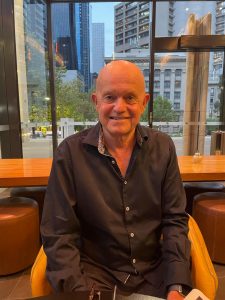Senior crime reporter at The Age John Silvester on the pressures of working in the field.

John Silvester. By Charlotte Huston.
Journalists face a dilemma between performing their duty and protecting their mental health when reporting on graphic material.
Similar to emergency responders and police, journalists are members of a high-risk population in developing mild to severe mental health effects from frequent exposure to traumatic events.
The Age senior crime reporter John Silvester believes short-term thinking and the 24-hour news cycle is to blame.
“The urgent takes the place of the important…the mobile phone and devices means you’re nearly always in contact,” Silvester said.
“You’re not in a position to switch off.”
A 2012 research program by the International Society for Traumatic Stress Studies revealed a positive relationship between exposure to disturbing content and a deterioration of mental wellbeing.
The British survey found that frequent exposure to traumatic material increased the likelihood for journalists to develop post-traumatic stress disorder (PTSD), emotional distress, compassion fatigue, and trauma-related guilt.
Journalists often witness catastrophic situations firsthand and must provide a ‘sanitised’ version of events, which may lead to both primary and secondary trauma.
This is where journalists observe the tragedy as eye-witnesses and subsequently experience the emotional pain of the victims vicariously as a transference of grief and pain.
Yet there is little mainstream media attention of the mental health consequences suffered by journalists – despite legal recognition of the issue in Australia less than two years ago.
In 2019, a former crime reporter at The Age was awarded $180, 000 in damages by the newspaper after suffering psychological injury from covering serious and gruesome crimes in Victoria.
The plaintiff – who was not named and referred to as “YZ” – had been employed as a crime reporter at the publisher for six years and as a Supreme Court reporter for further three years.
The County Court of Victoria judge Chris O’Neill said that The Age had failed its duty of care in the “maintenance of a safe system of work, and the provision of appropriate instructions and supervision.”
“There ought to have been training and instruction to all new journalists and cadets, particularly those young and less experienced, as to the nature of the trauma, suffering and distress to which they were likely to be exposed, in the plaintiff’s case, as a crime and court reporter,” O’Neill said.
The plaintiff reportedly abused alcohol to manage symptoms of depression and anxiety.
Coping mechanisms can play out in both beneficial and harmful behaviours.
Ball State University assistant professor Natalie Seely said it was healthy for journalists to develop self-care routines and support systems with friends, family and counsellors.
Dr Seely said negative behaviours like compartmentalising emotions, social isolation, and using substances to minimise mental distress were “ineffective and possibly lead to exacerbation of PTSD symptoms.”
And individual action can only go so far.
As shown in the 2019 court case, a large majority of onus falls on correcting newsroom culture and managerial approaches to employee wellbeing – especially when working in high-stress areas of a publication such as crime.
This can take shape in providing greater training for inexperienced reporters, removing the stigma surrounding seeking guidance, or allowing journalists to have interim breaks between news stories.
But the modern media landscape in Australia is increasingly contracted with the loss of nearly 200 newsrooms since 2019, elevating fears of unemployment and workload pressures.
The school of hard knocks – with its rigid organisational norms – does not work in an insecure industrial climate.
And neither does it foster a healthy environment for mental health.
(Featured image: Pixabay)



